PLANNAR, the continuation
As a continuation of my research, I've iterated the design of my mobile AR app PLANNAR to adhere to new spaces and stakeholders. The following two are recent engagements I’ve had with the Chinatown Sustainability Dialogue Group and the Museum of Neon Art in Glendale, CA.
Context 1: Short Visioning Workshop with CCED
Summary
Chinatown Sustainability Dialogue group was working on reaching out to different community groups in Chinatown to get their input and sponsorship of a People's Plan they had put together. Not wanting to worry about ownership of large analog papers, they asked me if I could design them a mapping AR app.
Chinatown Sustainability Dialogue group was working on reaching out to different community groups in Chinatown to get their input and sponsorship of a People's Plan they had put together. Not wanting to worry about ownership of large analog papers, they asked me if I could design them a mapping AR app.
Role
UX/UI Design
Facilitator
UX/UI Design
Facilitator
Timeline
3 days
Tools
Unity 3D
Adobe Illustrator
3 days
Tools
Unity 3D
Adobe Illustrator
Iteration
For this new context, the purpose was not to ask the community for what they wanted from scratch, but to have a pre-populated library of assets that reflected the new policies written in the People's Plan and see if there was consensus among the community.
Constraints
- Audience: CCED is comprised primarily of high school - early college students who were tenant activists and familiar with Chinatown's issues.
- Short time slot: Since these meetings ran on a tight schedule, I was given 10 minutes on the agenda to engage
- Pre-defined assets: CSDG had developed a written document with desires from the community expressed in a number of other meetings.
Agenda
I facilitated this short activity and asked members to for the first five minutes, talk amongst their group and pin down at least 5 items in certain parts of the Chinatown map, and ultimately photograph their creations. I made sure to design an activity where everyone was engaged--while one person pinned and photographed, the rest looked and pointed on the map where to place it. During this activity, I walked to each group and demonstrated how to place the pins, while also playing a looping video tutorial of how to use the app on the powerpoint slide.

Part 1: Mapping Community Desires (5 minutes)
I facilitated this short activity and asked members to for the first five minutes, talk amongst their group and pin down at least 5 items in certain parts of the Chinatown map, and ultimately photograph their creations. I made sure to design an activity where everyone was engaged--while one person pinned and photographed, the rest looked and pointed on the map where to place it. During this activity, I walked to each group and demonstrated how to place the pins, while also playing a looping video tutorial of how to use the app on the powerpoint slide.

Part 2: Feedback (5 minutes)
For the second part of the activity, I asked them to put ‘ipads down’ and write on post-it notes elements they thought were missing and place the post-it notes in the allotted “Additional” area adjacent to the map. I asked them to hold on to the post-it’s during the remainder of our presentation in case they thought of something else. Later on in the presentation, we asked them to report back on what they pinned and wrote down.

Pins I created for this workshop
Demo I displayed on the screen as participants familiarized themselves with the task
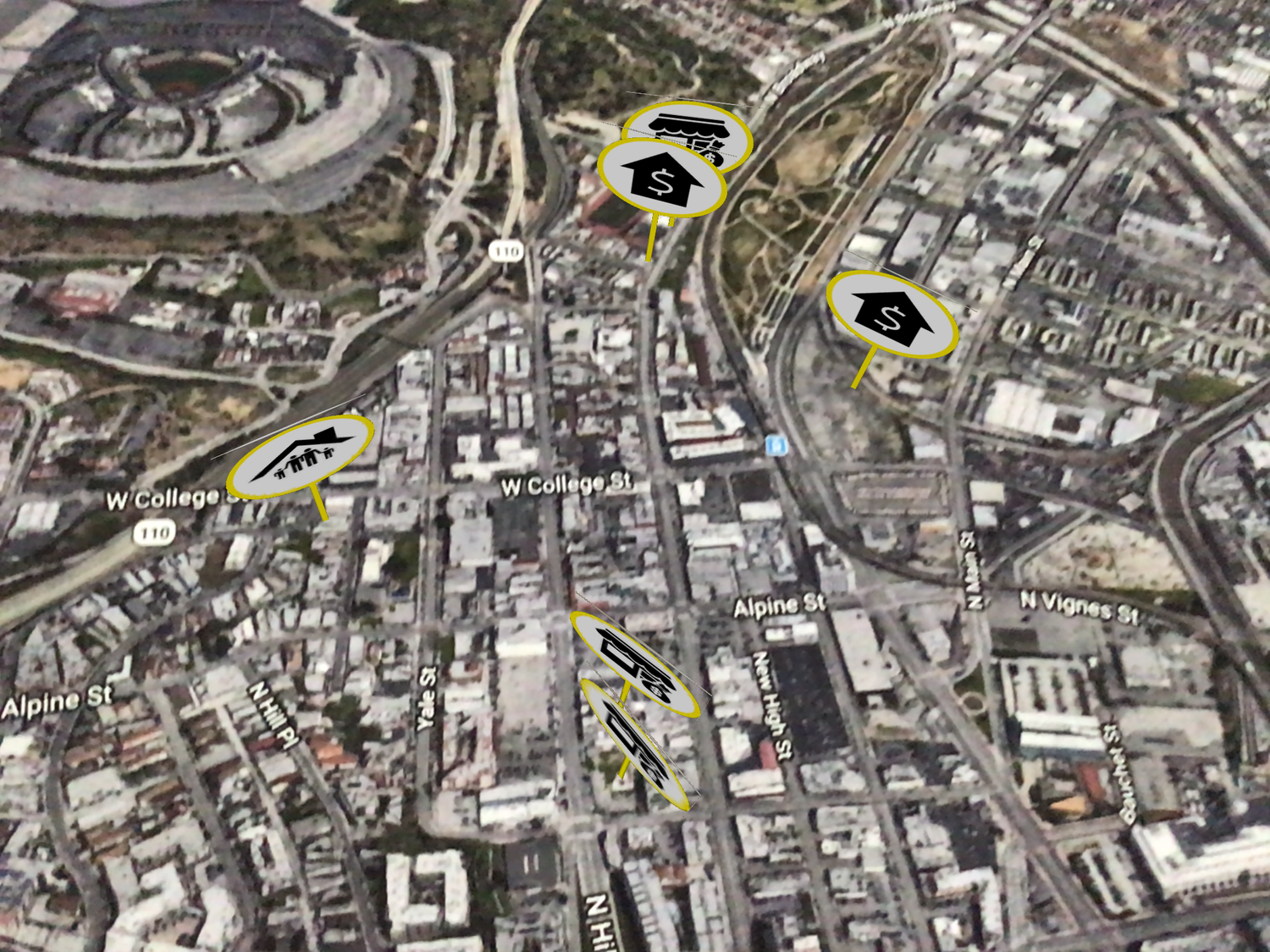
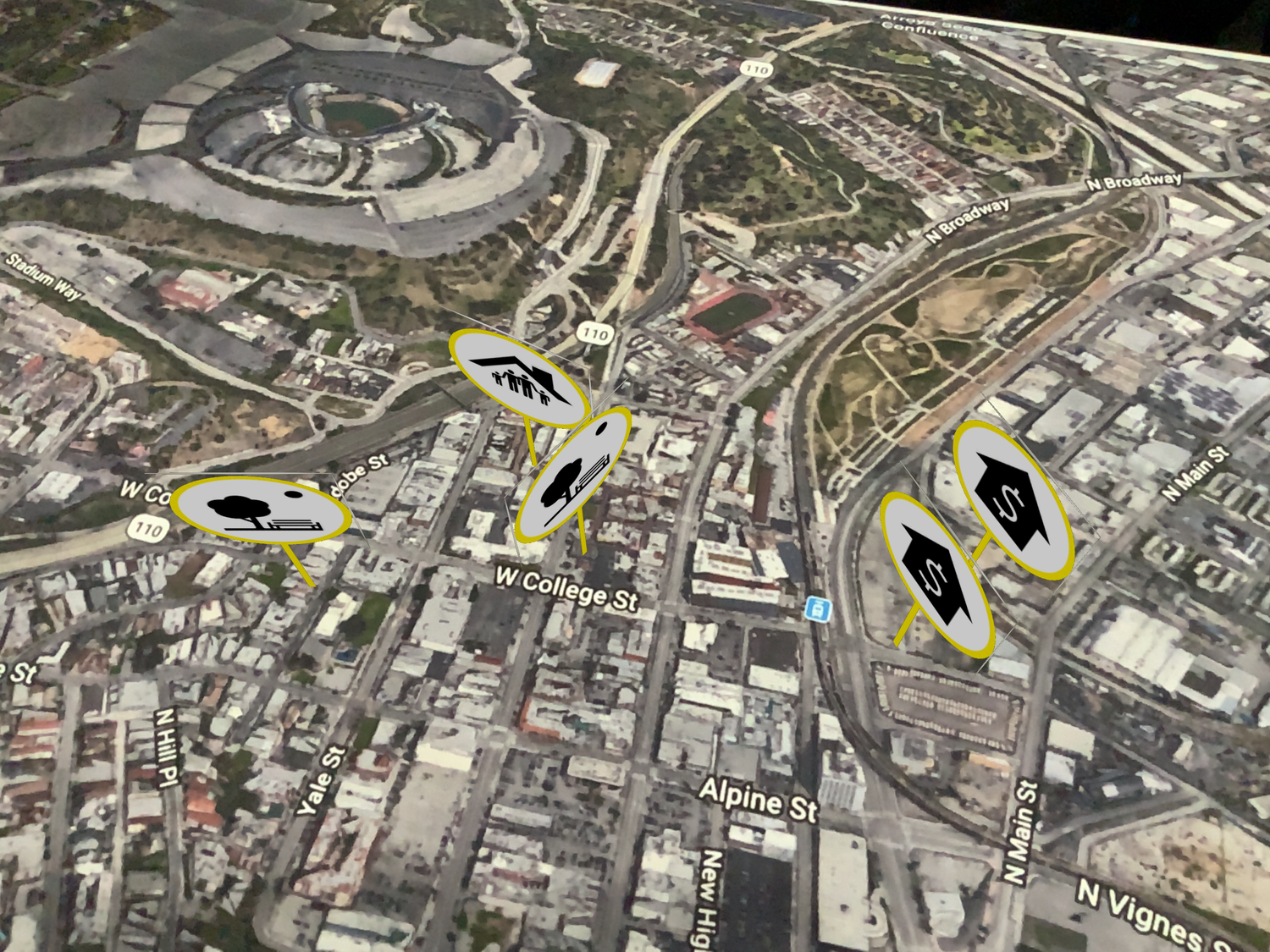
Conclusion
This exercise was surprisingly successful in terms of setting the tone for the conversation about asking for community sposorship of a community plan. The participants found the activity to be engaging and fun, and felt that it gave them a quick way to express their desires. One of the participants had tried PLANNAR app's first iteration and mentioned to me afterwards that this version "made more sense" and seemed more "actionable."
Next Steps
I was not able to continue the workshops because of scheduling conflicts, but if I were to continue this, I would create and upload 2D pins based on the post-it notes and other feedback given from the participants.
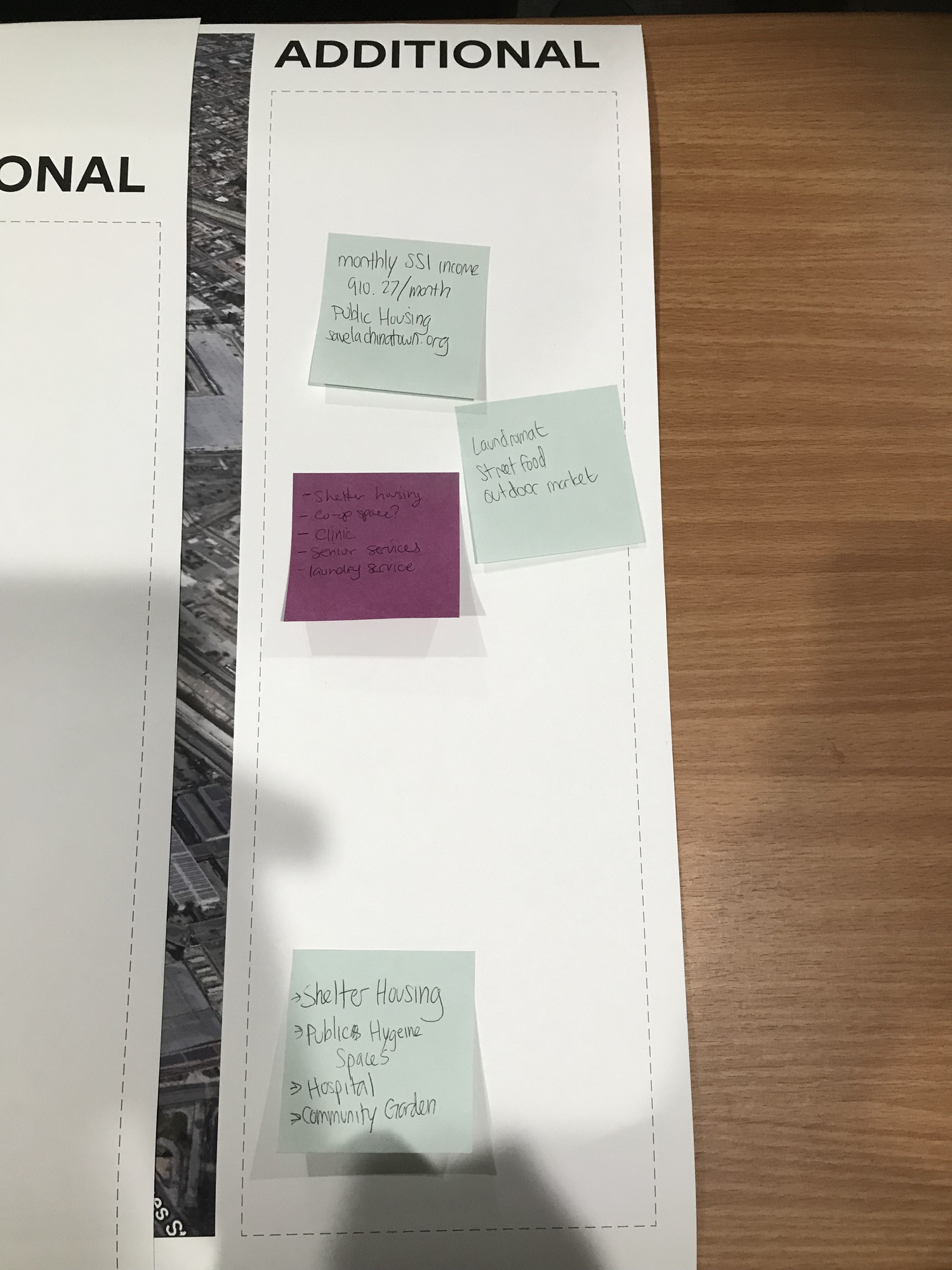
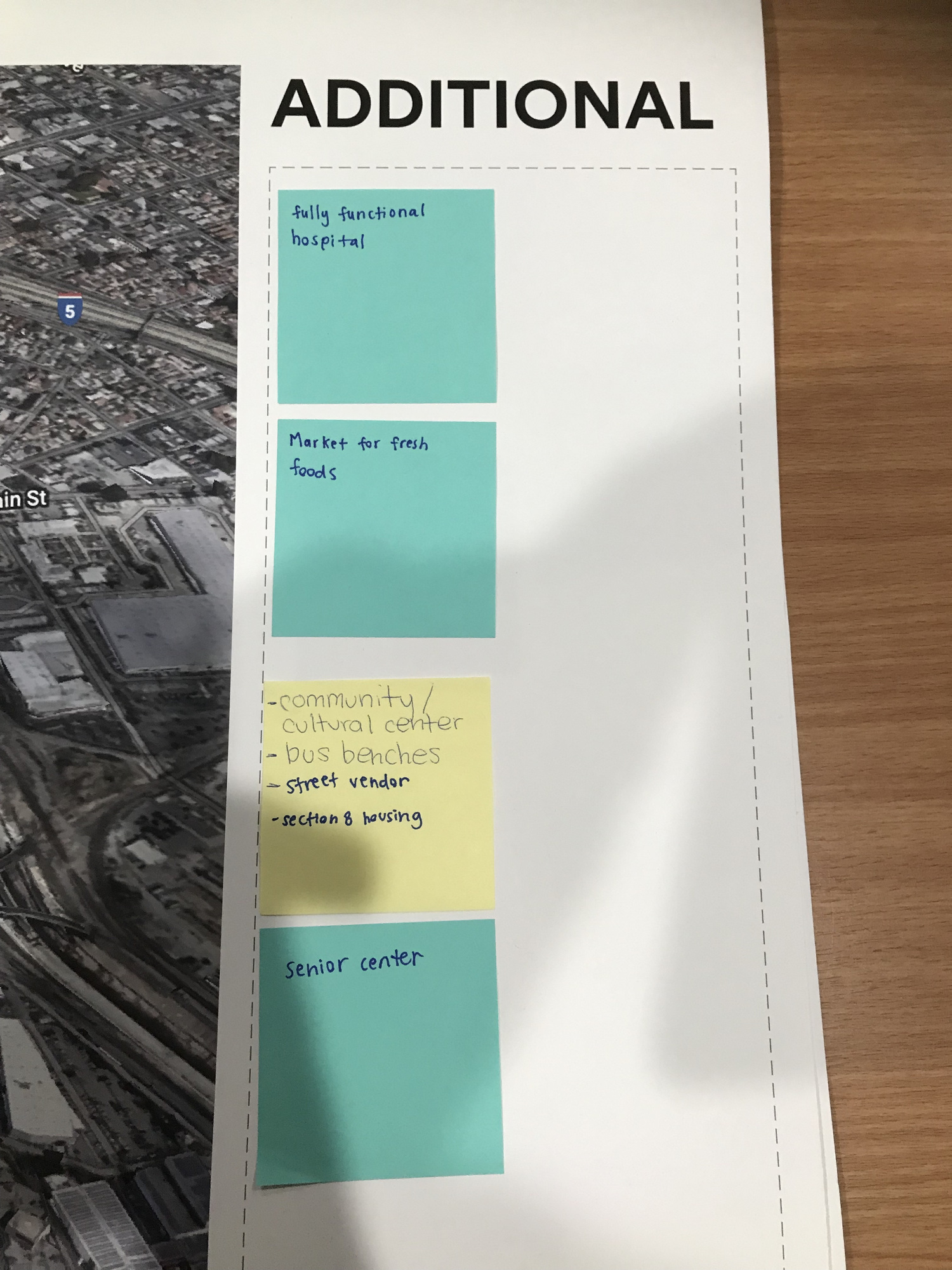
Context 2: Pop-up Exhibit @MONA
Summary
I was invited to participate in Glendale Tech Week's "Floating Signifiers" exhibit and introduce my work with PLANNAR as a pop-up at the Museum of Neon Art in Glendale, CA.
I was invited to participate in Glendale Tech Week's "Floating Signifiers" exhibit and introduce my work with PLANNAR as a pop-up at the Museum of Neon Art in Glendale, CA.
Role
Artist
Facilitator
Artist
Facilitator
Timeline
2 weeks
Tools
Unity3D
Adobe Illustrator
2 weeks
Tools
Unity3D
Adobe Illustrator
Iteration
This context was similar to the workshop I led at CCED, only that this time, there was more loose facilitation and self-initiated participation.I designed the table to have three main calls to action:
-
Pick up the iPad to place AR objects on the map
- Pick up the pens and post-it notes and place them in two sections (less of and more of)

Since I wanted to attract visitors to participate in the visioning exercise and discussion, I designed a poster explaining what the purpose of the pop-up was and used bright colorful palettes. I curated some assets to include smart city infrastructure (I had seen some article tlak about how 5G is killing birds as a contentious subject) and cubes to symbolically represent "affordable housing."
As the output of the AR maps did not have utilitarian use, I envisioned the out of the maps to be more of spatial collages and less informative/diagrammatic maps.
Constraints
- Audience: Everyday visitors to the Museum of Neon Art, participants of Glendale Tech Week of all ages and ethnicities.
- Time slot: I was given two hours to exhibit this work.
- Assets: In my initial conversations with the curators of the exhibit, I was told of existing tensions with specific developments (i.e. the cultural history and strong Armenian influence, burgeoning 'Silicon Mountains' branding
Insights
- People were generally very excited about their ability to participate in the discussion, but had expectations that this information would be spread on social media or would reach the Mayor of Glendale in some way
- People of all ages were really interested in seeing the 3D representations of their maps
- Young people understood the concept of the app better than adults, and were more willing to generate ideas
- The quick AR engagement triggered lengthly conversation about what they wish existed more and less in their community
- Interesting to see transplants refrain from participating in the exercise altogether
Conclusion
One persistent limitation of this method is that there is not a quick way to create 3D assets that represent all of people's ideas - so more thought into the assets as a commnunity vocabulary would have to be redesigned. For the time being, I'm using post-it notes as an additional way to participate in the discussion. With more participation, it would be interesting to see patterns emerge and see how the conversation can reach different scales on social media.Next Steps
There is potential for PLANNAR to exist as a new form of community engagement in Glendale's Urban Design studio! I’m excited to see how this project will evolve with access to insights from planners, continuous engagement, and better pool of participants (residents from the community).






Autodesk - Future of Work
Client: Autodesk, Office of the CTO, Corporate Strategy team
Team: Radha Mistry (story strategist), Yime del Santiago (illustrator)
Role: Researcher, conceptual designer, produced prototype artifacts for workshops, co-facilitator for stress-testing workshops
Summary
The Future of Work Worldbuilding Project was completed during a 3-month internship at Autodesk’s Office of the CTO with the Corporate Strategy team during summer 2018. The purpose was to employ strategic foresight and develop four finely textured and researched speculative scenarios about the implications of automation on Autodesk’s tools and customers, using fiction to prototype the future. What emerged were scenarios that included a season, terrain, artifact, and set of characters that used technology to adapt their career paths to new circumstances. Each were based on many in-person stakeholder interviews, reports, and current events. Set roughly in 2030, the scenarios are not meant to be a perfect prediction of the future, but rather serve as provocation for further tailoring Autodesk’s corporate strategy to a preferred future that has been stress-tested with stakeholders in the industry.
The Future of Work Worldbuilding Project was completed during a 3-month internship at Autodesk’s Office of the CTO with the Corporate Strategy team during summer 2018. The purpose was to employ strategic foresight and develop four finely textured and researched speculative scenarios about the implications of automation on Autodesk’s tools and customers, using fiction to prototype the future. What emerged were scenarios that included a season, terrain, artifact, and set of characters that used technology to adapt their career paths to new circumstances. Each were based on many in-person stakeholder interviews, reports, and current events. Set roughly in 2030, the scenarios are not meant to be a perfect prediction of the future, but rather serve as provocation for further tailoring Autodesk’s corporate strategy to a preferred future that has been stress-tested with stakeholders in the industry.
Outcome
External Media:
The Autodesk University 2018 Opening Keynote with Andrew Anagnost, featuring the Los Angeles Winter 2030 scenario.
Redshift Article “Smart Reuse of Olympic Infrastructure Could Bring Home the Gold for Host Cities”
Radha Mistry’s speculative fiction based on the four scenarios:
“Winter 2030: A Metropolis in Transit”
“Spring 2030: Robot Trainers and Small Town Mayors”
“Summer 2030: Micro-factories as First Responders”
“Autumn 2030: Rapid Recovery”
External Media:
The Autodesk University 2018 Opening Keynote with Andrew Anagnost, featuring the Los Angeles Winter 2030 scenario.
Redshift Article “Smart Reuse of Olympic Infrastructure Could Bring Home the Gold for Host Cities”
Radha Mistry’s speculative fiction based on the four scenarios:
“Winter 2030: A Metropolis in Transit”
“Spring 2030: Robot Trainers and Small Town Mayors”
“Summer 2030: Micro-factories as First Responders”
“Autumn 2030: Rapid Recovery”
Frameworks
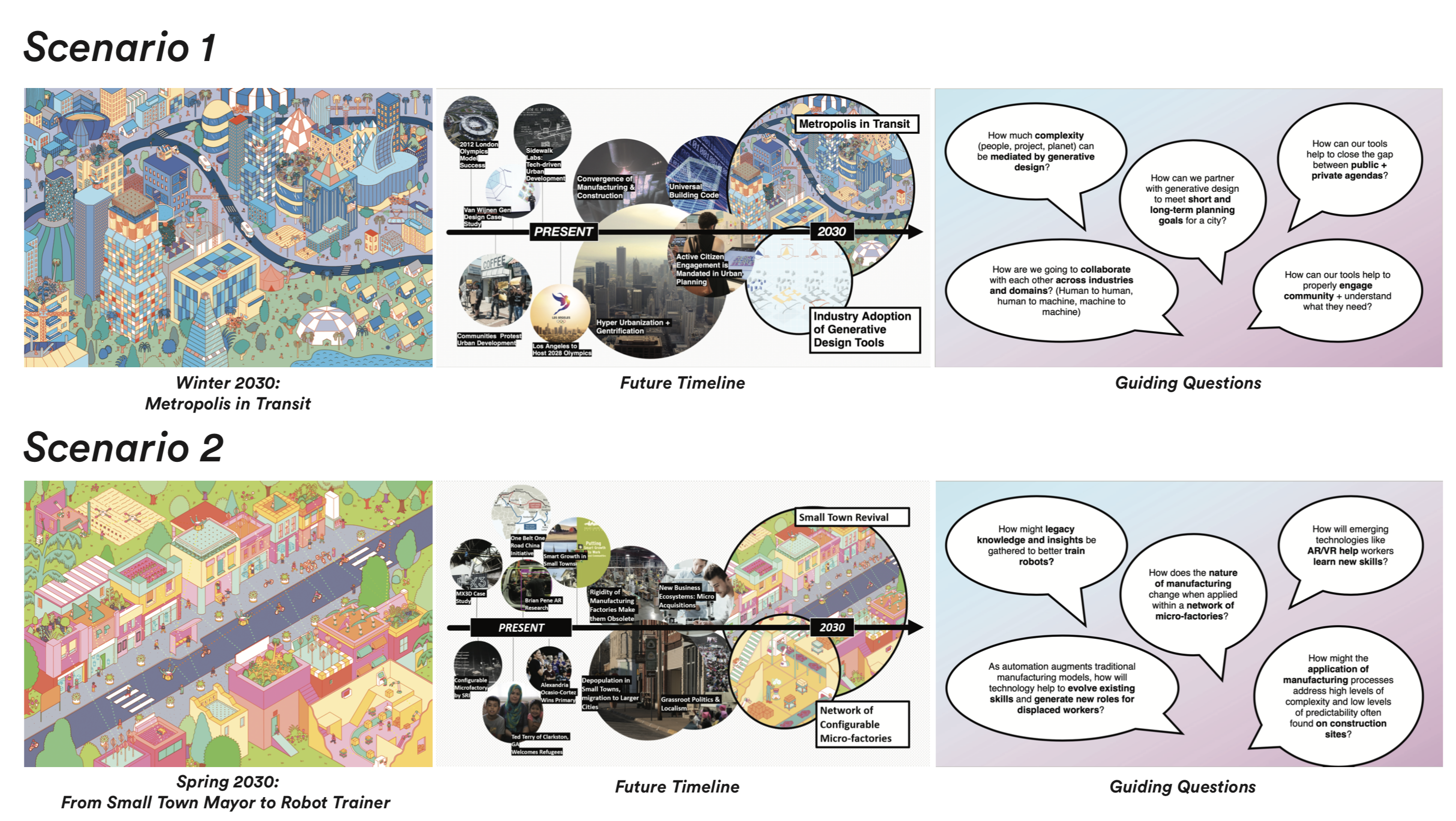

Workshops
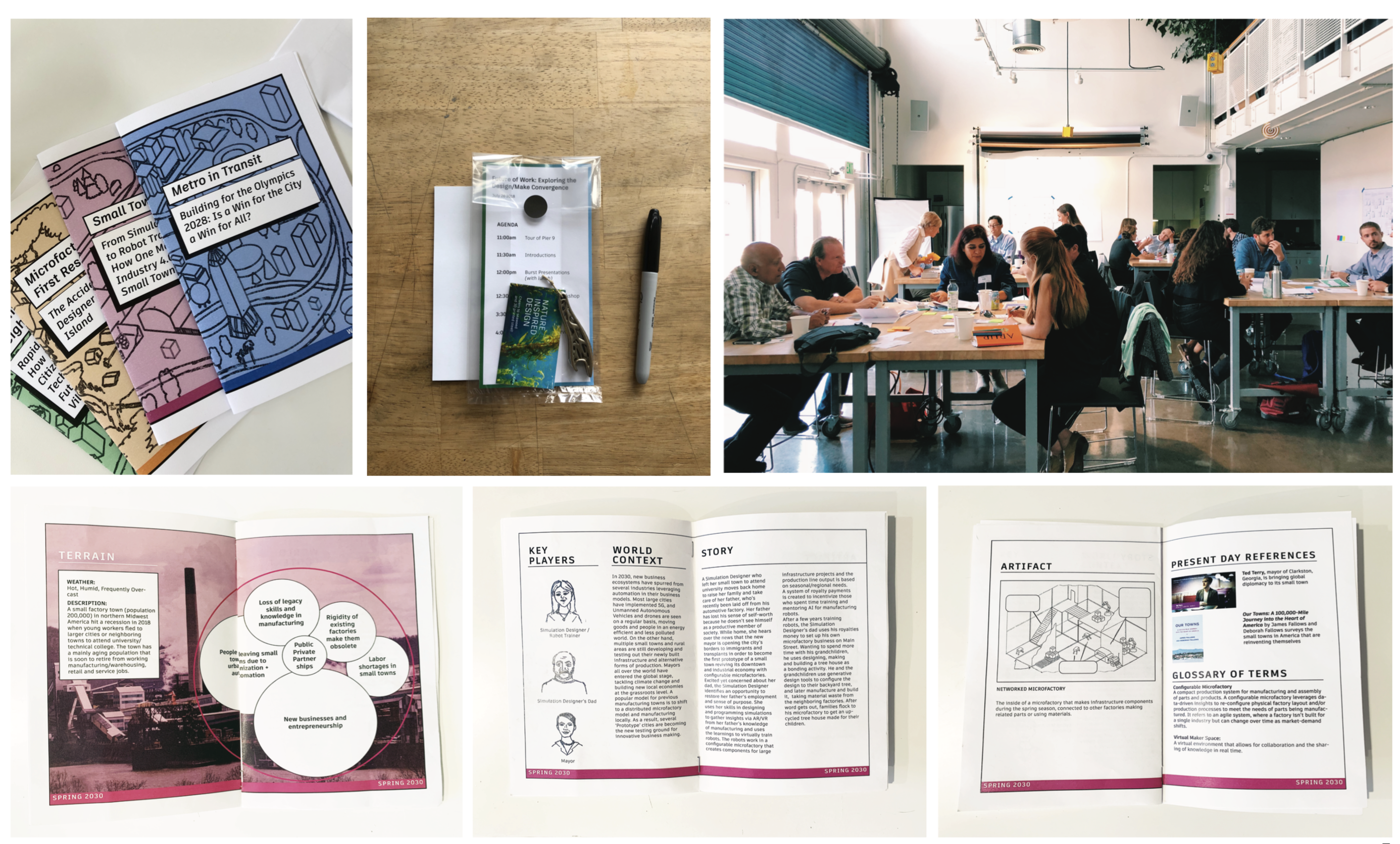
Process
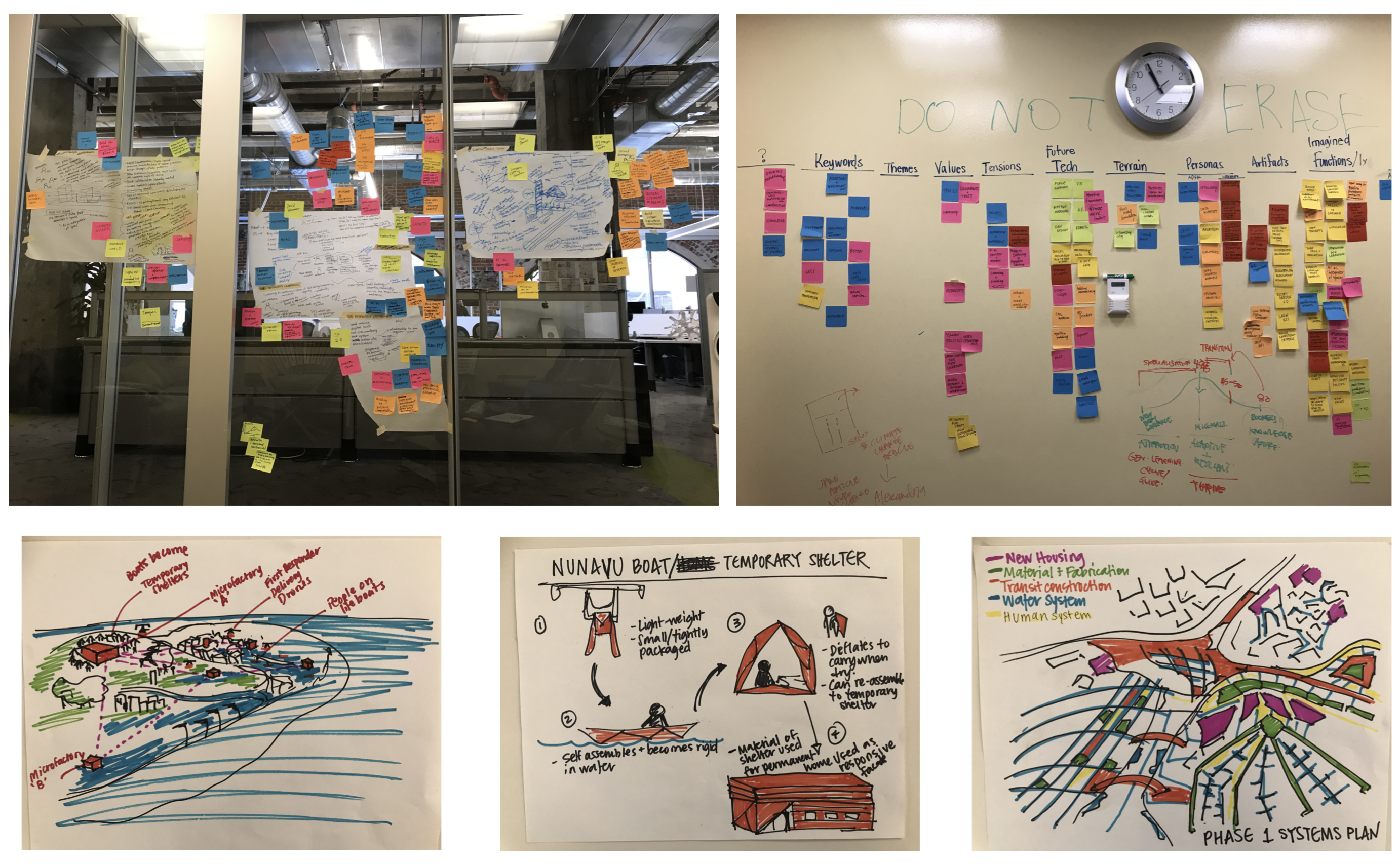
Why should the future of humanity be shaped by capitalistic principles?
Summary
GLACIA is the name given to a mineral found in the glaciers of Mars lava tubes by a posthumanist astrobiologist, who, dissenting from the capitalistic politics of Elon Musk’s SpaceX colony, left in search for agency over their own future on Mars. GLACIA is also the title of a media ecology of design fiction, interactive experience, and collection of artifacts designed to inspire the viewer to consider futures of living on Mars different from those presented in science fiction and current advertisements for the Mars mission.
Tools + Materials
Rhino3D
Unity3D
Adobe After Effects
Adobe Photoshop
Timeline
2 weeks
Rhino3D
Unity3D
Adobe After Effects
Adobe Photoshop
Timeline
2 weeks
Role
Strategy, Visual Research, 3D Modeling, Animation, Video Editing, Physical Modeling
Strategy, Visual Research, 3D Modeling, Animation, Video Editing, Physical Modeling
Context
This is part 1 of an ongoing series about speculative Mars narratives as told by different walks of life. For this project, I sought to explore how the addition of tangible artifacts made from familiar production process-cooking, extracting--might spark a different level of immersion than just a standalone VR experience.
Visual Research
Analyzing depictions of mars colonization, I found patterns of the same type of architecture, hue, and visions.
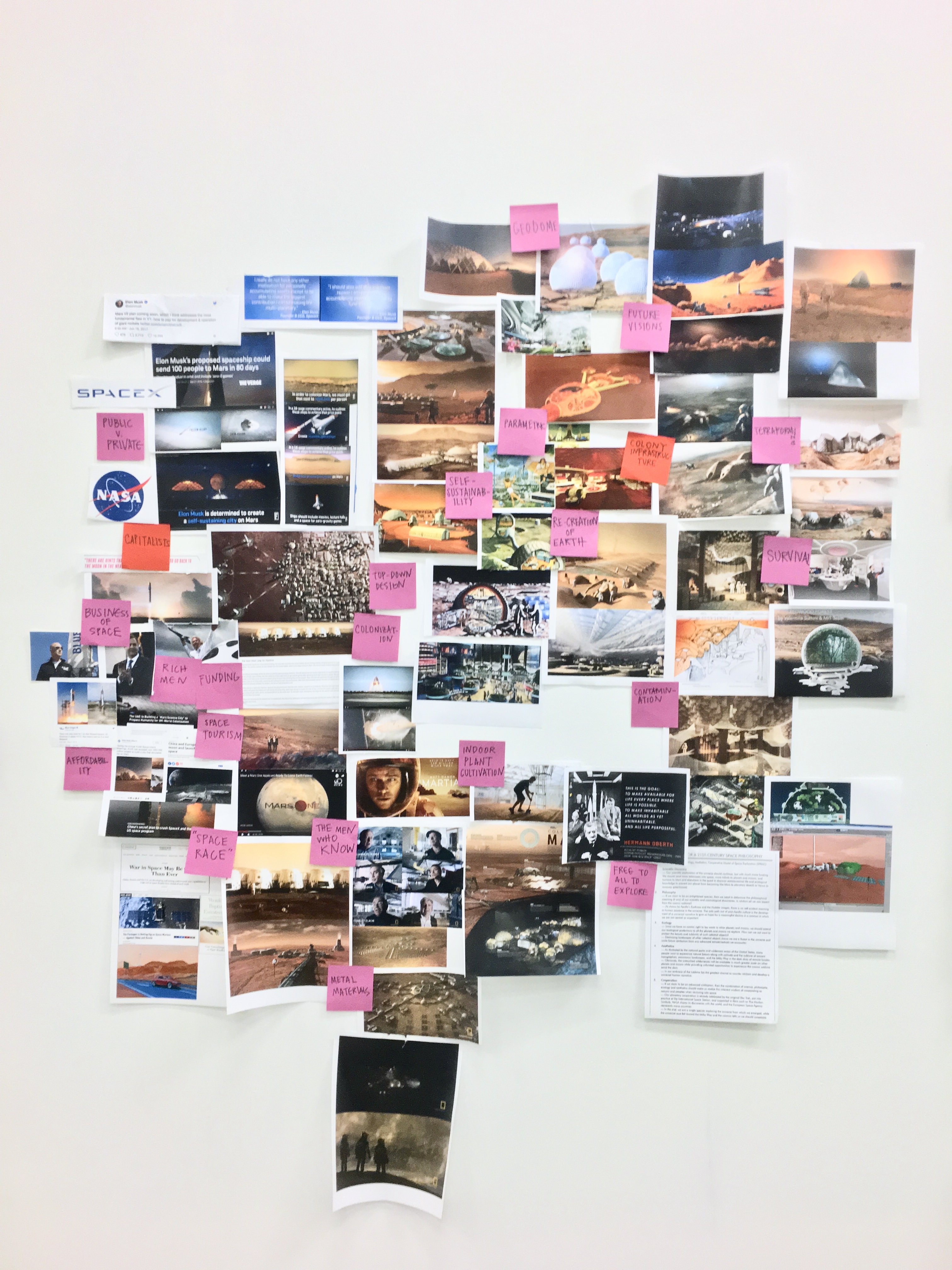
Value Comparison
I initially focused on defining the value system of the character, influenced by the categorization of speculative populations in Dunne and Raby's United Micro Kingdoms. On the left is the list of the Mars Colony world values and on the right is the alternative world values. From there, I imagined a character that would embody these alternative world values and wrote a design fiction.

Design Fiction Synopsis
It's 2055, and the first Mars colony has been made possible by private investment and Elon Musk, the CEO of SpaceX, who believes that the manifest destiny of humanity (America) is to become a multiplanetary species. The colony of 100 habitants has replicated Earth 2.0, building domes and sterile suburbia occupied by NASA scientists, local 'officials,' tourists, and people who gave up on earth and are searching for alternative purpose to life. But for the most part, Mars is for those who can afford it, those who are seen as providing 'value,' and those who run the show exploiting resources and building the economy on Mars.
 Astrobiologist’s GLACIA Cave Painting
Astrobiologist’s GLACIA Cave PaintingFed up with constant NASA budgeting decisions favoring economical value over exploration, the main character takes off on a Space Exploration Vehicle (SEV), a mining robot, their field equipment, food, and astronaut suit. They aim for the next landing site that includes a lava tube, in search for glacial water. After mining through the tube, the astrobiologist discovered blue particles in the air, possibly coming from the walls of the basalt lava tube. After analyzing the sample of basalt, they conclude that the elements' configuration contains properties that allow for an unprecedented reaction of energy and oxygen exhaust. The astrobiologist then finds the glacier, and next to it, a sun spot that has high concentration of what he names GLACIA in its small diameter.
 View of the chamber from above
View of the chamber from aboveAfter 30 SOLs, the astrobiologist has run out of human food and is dependent on recipes, cooking, and harvesting system they have designed utilizing a combination of GLACIA concentrations with Mars basalt. Part of the "cooking" process is utilizing the sun that shines through the hole, incubating the heat and radiation with disassembled parts from the NASA SEV. They have also decided to stay there permanently to try to see if it's possible to live off Mars' natural resources.
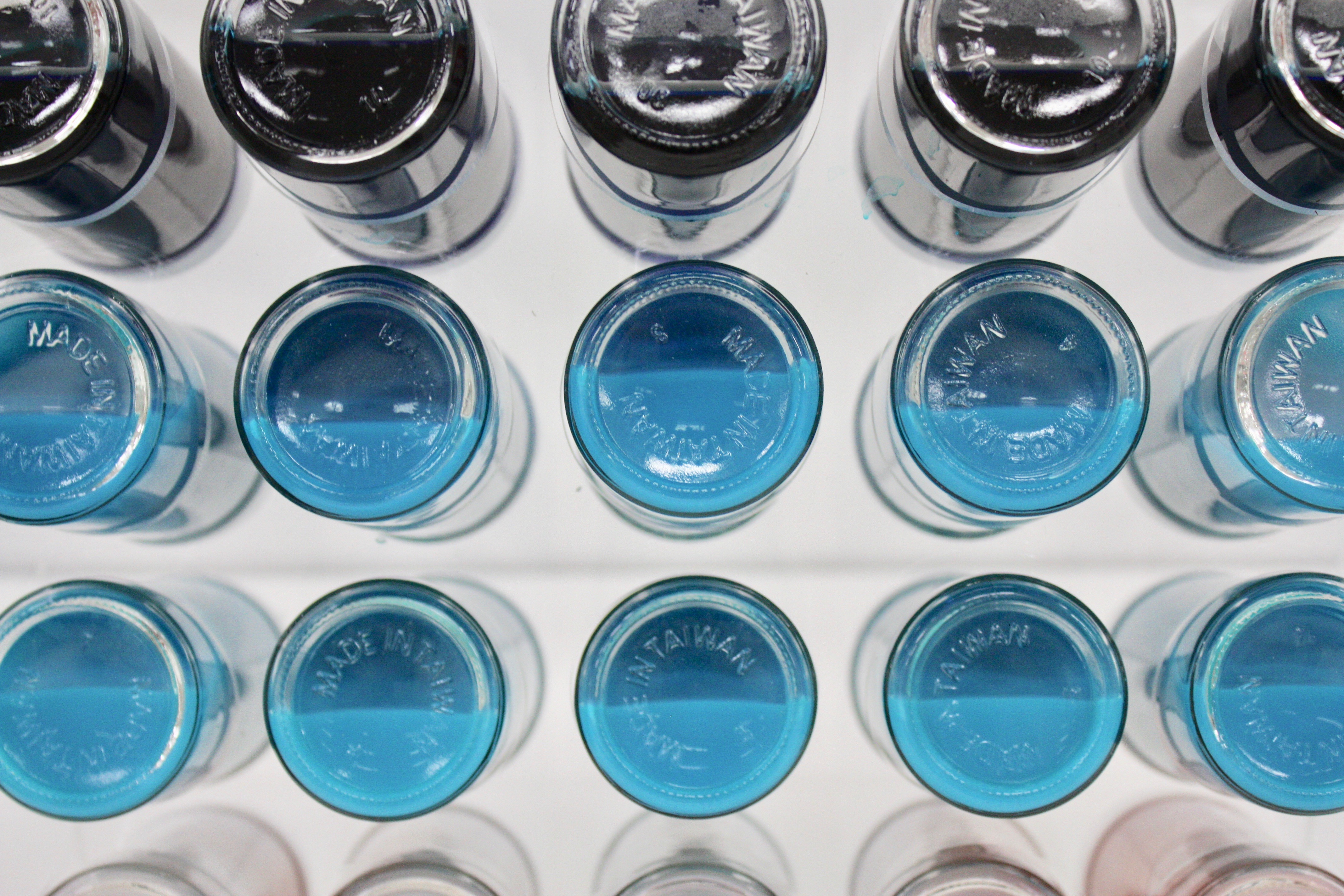
After 50 SOLs, the astrobiologist has reached a mental state of transformation. Exposure and consumption of GLACIA has altered their body such that deposits of mineral are replacing their original bone structures, and their skin has thinned, requiring more heat. The astrobiologist, seeing these biological effects has concluded that they have reached a new hybrid state of functioning.


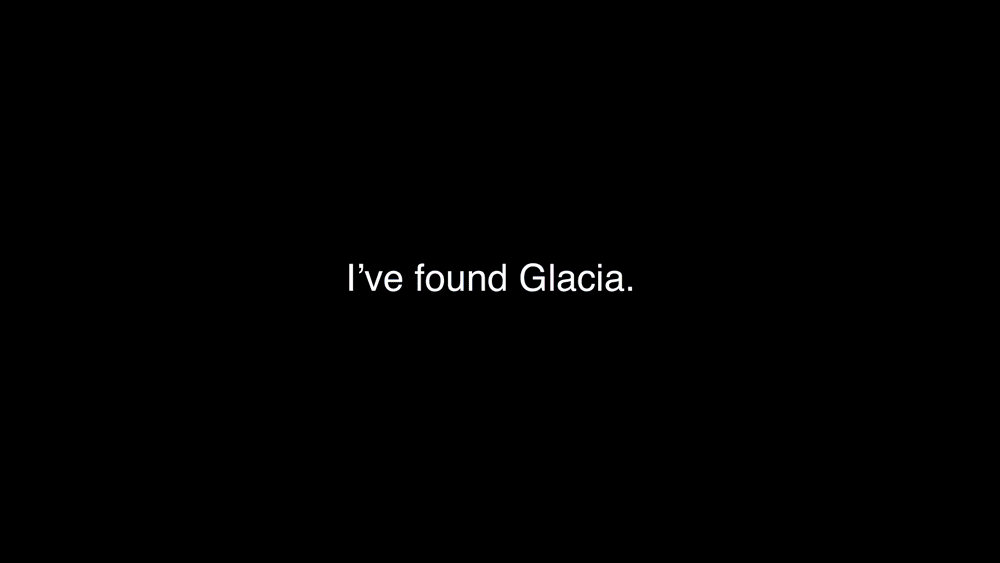
Glacia Cosmovision
Convinced that they are reaching immunity to the atmospheric conditions of Mars, they renounce their astronaut suit and breathe GLACIA particles in the sun-filled chamber. Staying for SOLs in isolation with nothing to look at other than the sun above, the astrobiologist begins hallucinating, thinking that they have reached a new state of conscious, vomiting as a sign of purifying, dizziness as transformation, and muscle malfunction as possession. In reality, the astrobiologist dies quickly from radiation exposure and malnutrition. When his body was found, a collection of spheres of red and blue dots were stored under a part of the SEV. They were fruits. Indeed, the astrobiologist had found a way to cultivate Mars resources to reproduce and spread seeds on Mars land.

Astrobiologist’s Notebook




I created a diary that told the story based on notes and sketches.
Immersive VR/Film



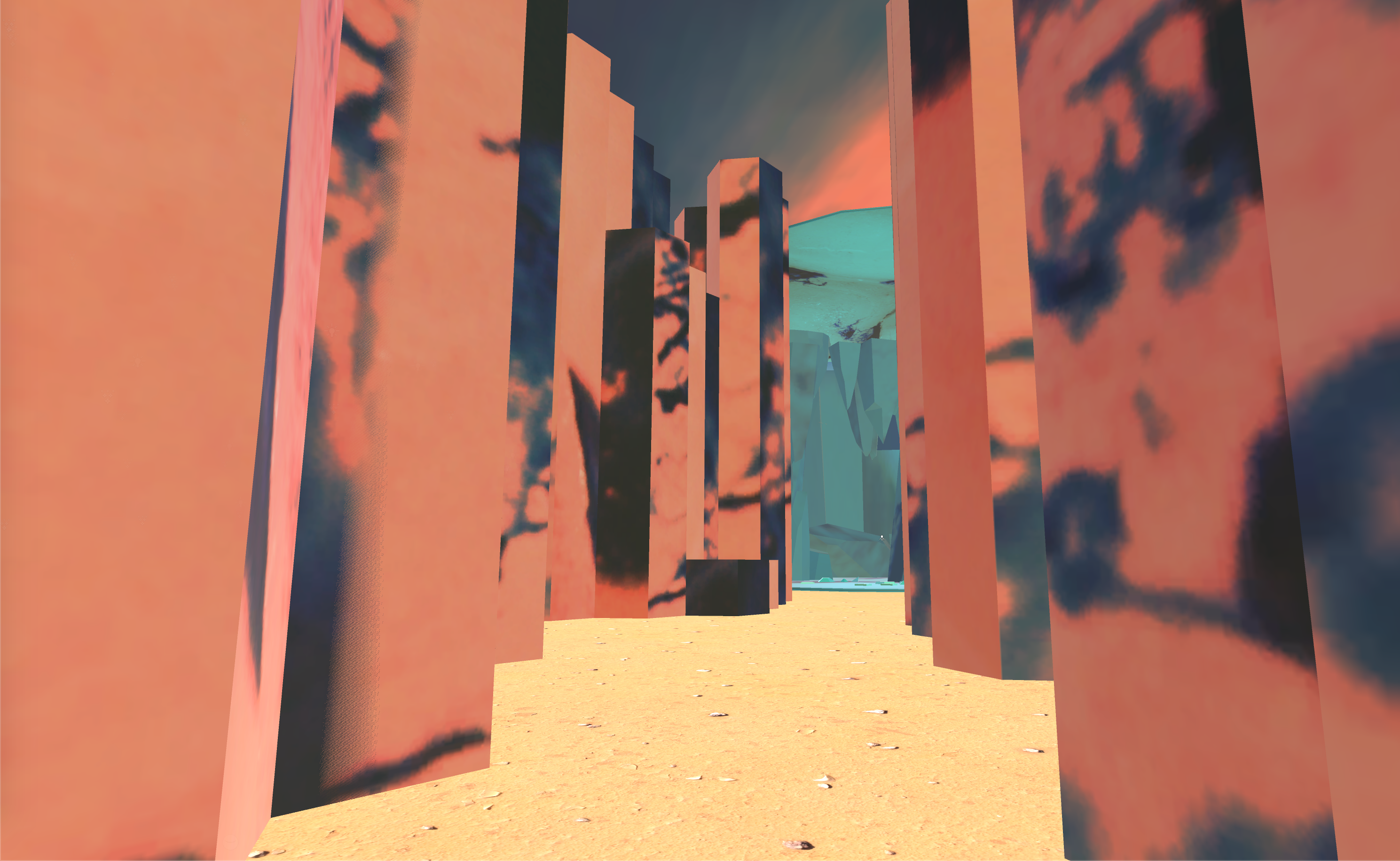
The main objective of the VR experience was to immerse the viewer in the exploration and discovery of GLACIA particles, the glacier and the sun chamber. Originally I wanted to use an HTC vive so the player could move around but was not able to gain access to the technology. As a result, the VR visuals I wanted to highlight were compressed into a short trailer of the entire story. This seemed like a nice alternative to the VR experience since the project was so narrative based and detailed.
Artifacts Supplementing the VR Experience
I took a scientific/experimental approach to extracting, ‘cooking’ GLACIA materials, and a proposed GLACIA fruit--symbolizing the evolutionary biology of GLACIA.

Basalt rock with glacia pores

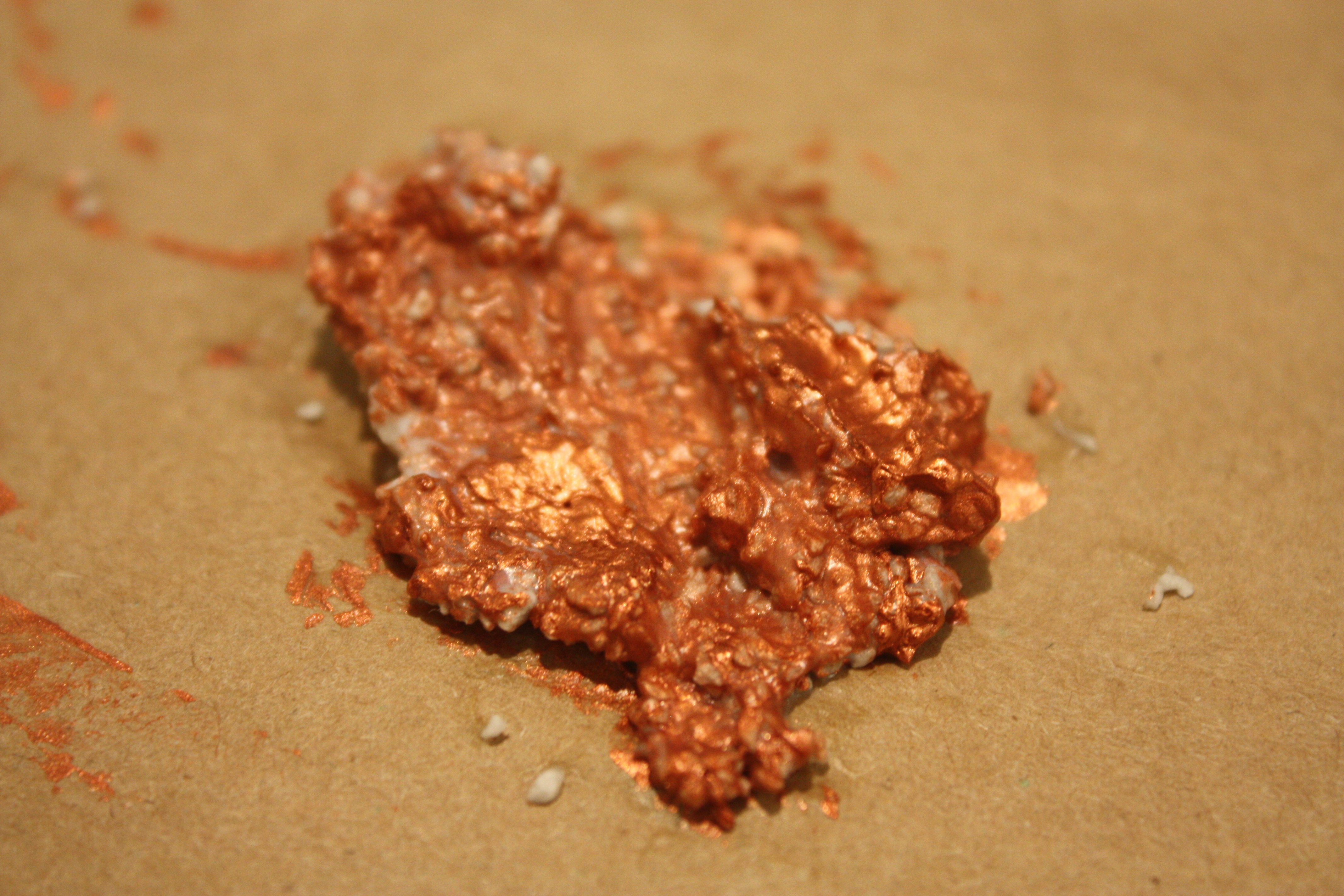



Cooking GLACIA:





Liquid/frozen solutions of GLACIA:


GLACIA fruit


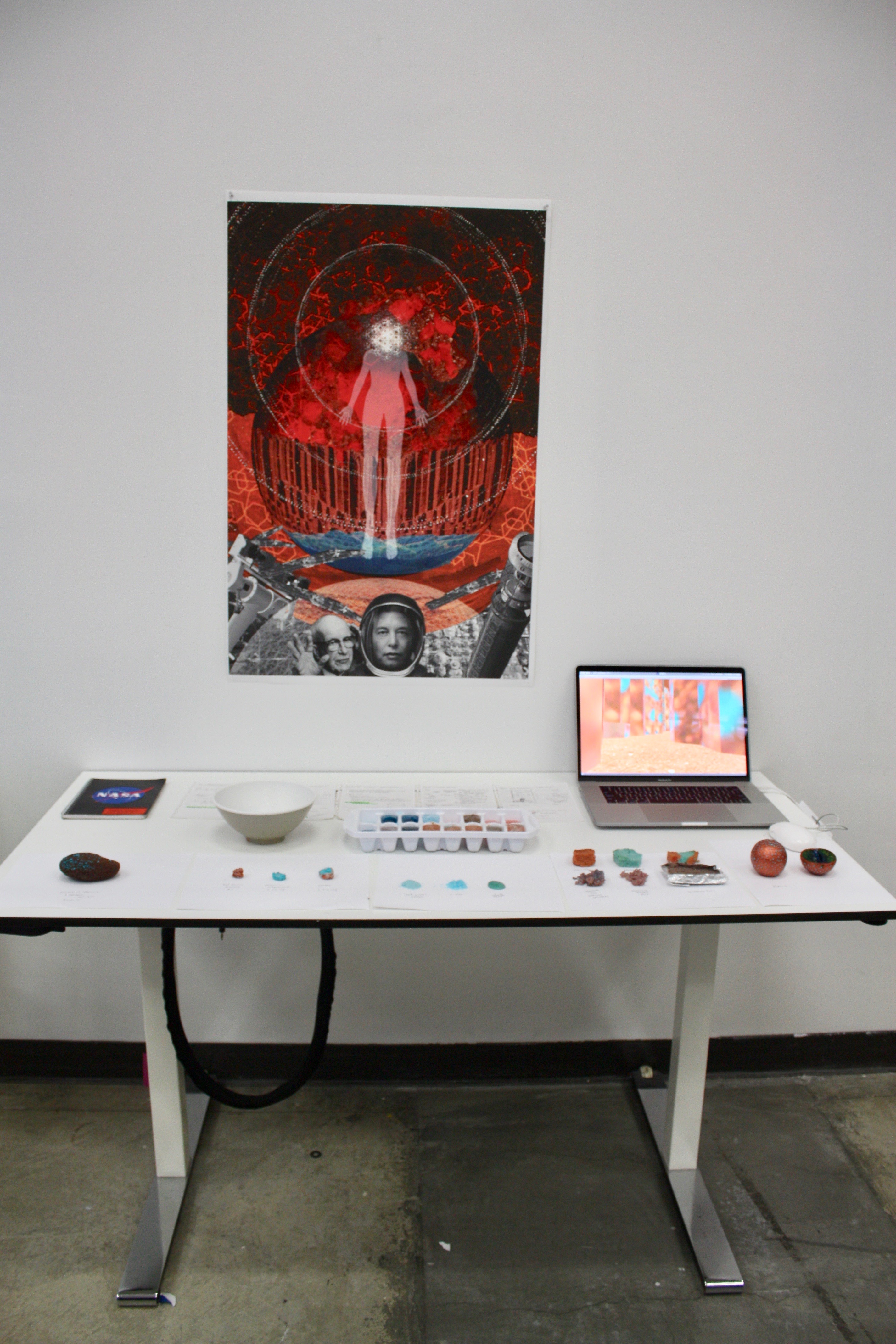
 Final Presentation
Final Presentation